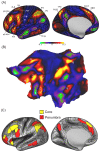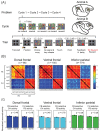Integrated Intelligence from Distributed Brain Activity
- PMID: 32771330
- PMCID: PMC7116395
- DOI: 10.1016/j.tics.2020.06.012
Integrated Intelligence from Distributed Brain Activity
Abstract
How does organized cognition arise from distributed brain activity? Recent analyses of fluid intelligence suggest a core process of cognitive focus and integration, organizing the components of a cognitive operation into the required computational structure. A cortical 'multiple-demand' (MD) system is closely linked to fluid intelligence, and recent imaging data define nine specific MD patches distributed across frontal, parietal, and occipitotemporal cortex. Wide cortical distribution, relative functional specialization, and strong connectivity suggest a basis for cognitive integration, matching electrophysiological evidence for binding of cognitive operations to their contents. Though still only in broad outline, these data suggest how distributed brain activity can build complex, organized cognition.
Keywords: attention; brain networks; cognitive control; intelligence; neural coding.
Copyright © 2020 The Authors. Published by Elsevier Ltd.. All rights reserved.
Figures






References
-
- Duncan J, et al. Intelligence and the frontal lobe: The organization of goal-directed behavior. Cognit Psychol. 1996;30:257–303. - PubMed
-
- Kane MJ, Engle RW. The role of prefrontal cortex in working memory capacity, executive attention, and general fluid intelligence: An individual-differences perspective. Psychonomic Bulletin and Review. 2002;9:637–671. - PubMed
-
- Unsworth N, Robison MK. A locus coeruleus-norepinephrine account of individual differences in working memory capacity and attention control. Psychonomic Bulletin and Review. 2017;24:1282–1311. - PubMed
Publication types
MeSH terms
Grants and funding
LinkOut - more resources
Full Text Sources

